Ray Hahn
The Dravo Corporation:
Naval Victory
The Delaware Valley’s second city, Wilmington, Delaware, wins bragging rights when compared to other cities, nationwide, that have redeveloped areas of their cities into parks or business centers. In Wilmington, for nearly two miles, along S. Madison Street, the redevelopment companies have decided to emphasize the arts, entertainment, and retail shopping, but while doing a fine job at that, they have not forgotten their history. At the foot of Madison Street there is a beautiful, little parkland setting featuring a monument that certifies the history of ship building in Wilmington. The central features of the park are three medium-duty cranes and a thirty foot wide compass that points to the eight major directions. The cranes have been restored and brightly painted to be emblematic of the work done in the shipyards along the Christiana River. The compass points to bronze plaques that honor World War II ships that were constructed at the Dravo Corporation.
One LST (Tank Landing Ship) and seven Cannon class destroyer escorts were built in Wilmington between early 1942 and mid-1944. On January 8, 1942, Admiral S. S. Robinson, Chief of the Bureau of U. S. Naval Ships, challenged the workers at Dravo in a speech at their dockside by saying, “If these vessels are produced in the time required, the war will be one year shorter than it will be if we fail.”
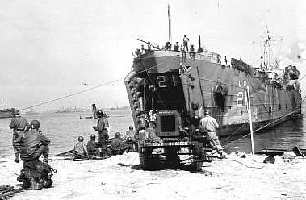
LST #21 “Blackjack Maru” was laid down on September 25, 1942; launched on February 18, 1943; and commissioned on April 14, 1943.
The Blackjack Maru was assigned to the European theater and participated in the Normandy invasion. Upon her return to the United States, the ship was decommissioned on January 25, 1946 and struck from the Navy list on June 19, 1946. She was sold to Louis Feldman, of Flushing, N.Y., on March 12, 1948 and was subsequently scrapped. LST-21 earned one battle star for World War II service.

USS Cannon [DE-99] was launched May 25, 1943 and commissioned September 26, 1943, Lieutenant Commander G. Morris in command. Cannon reported to the Atlantic Fleet.
On November 30, 1943, Cannon cleared Philadelphia for Trinidad, where she arrived December 5th to begin a year of duty escorting convoys from that oil rich island to Recife and Rio de Janeiro, Brazil. During this time, she made one voyage from Brazil to Gibraltar, guarding convoys whose tankers carried the fuel essential to the success of operations in the Mediterranean.
Cannon‘s protection of the Allied fuel supply through the dangerous sea lanes of the Caribbean and the Atlantic Narrows ended on December 4, 1944, when she arrived at Natal, Brazil, to begin training a
Brazilian crew. Cannon was decommissioned and transferred to Brazil on December 19, 1944. Through the 1960s she continued to serve in the Brazilian Navy as Baependi [U27]. (See photo). Baependi was
finally discarded in 1975.

USS Christopher [DE-100] was launched June 19, 1943 and commissioned October 23, 1943 with Lt. A.W.P. Trench in command. The first assignment for Christopher was to sail from Philadelphia on December 25, 1943
for duty off Brazil and Trinidad. Between January 16th and February 11th, she sailed off Montevideo, screening the British ship Cambria as she repaired broken cables. Similar duty continued until Christopher was decommissioned at Natal, Brazil, on December 19, 1944, and loaned to Brazil under lend-lease. She was renamed Benevente for Brazilian service. On June 30, 1953, when the loan ended, she was stricken from the U.S. Navy List and transferred to Brazil under the Mutual Assistance Program. The ship was d

USS Thomas [DE-102] was launched on July 31, 1943 and commissioned on November 21, 1943. Lt. Comdr. David M. Kellogg was given command. Thomas was named for Clarence Crase Thomas (1886–1917) the first United States naval officer to lose his life in World War I.
On December 7, 1943, Thomas got underway for Bermuda to conduct her shakedown cruise, which ended on January 15, 1944. Thomas then joined a Task Group to hunt submarines in the North Atlantic. From February 29, 1944 to March 31st, Thomas was credited with three U-boat (U-709, U-603 and U-801) kills. Later that summer, at sunset on July 5th, Thomas and Baker (DE-190) were approximately 100 miles south of Sable Island
when Baker developed a contact. Two depth-charge patterns brought the U-boat to the surface. Thomas set a collision course and bore down on the submarine with all guns firing. She sliced through U-233’s pressure hull about 20 feet aft of the submarine’s conning tower. The U-boat sank stern first in less than a minute. Thomas
rescued twenty survivors, including the captain. Two days later, she was detached from the task group to return to the Boston Navy Yard for repairs.
For the balance of 1944 Thomas patrolled different parts of the North Atlantic hunting submarines, and then on the night of April 29, 1945, they had one more U-boat (U-548) kill. A little more than a week later, Germany
surrendered, ending fighting in the Atlantic. When the war ended, Thomas was assigned less hazardous duties until decommissioning at Green Cove Springs, Florida, in March 1946. On October 29, 1948, the destroyer escort was transferred to Taiwan and renamed T’Ai Ho. Thomas was struck from the Navy list on December 22, 1948.
Thomas received four battle stars for World War II service.
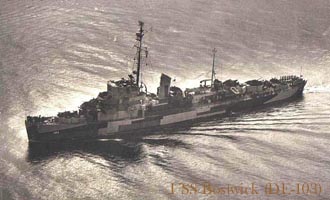
USS Bostwick [DE-103] was launched August 30, 1943 and commissioned December 1, 1943. In command was Lieutenant Commander J. H. Church Jr., USNR.
On February 15, 1944 Bostwick joined a Task Group and made a cruise between Hampton Roads and North Africa. On March 1st she joined Thomas and Bronstein (DE-189) in sinking U-709. After escorting a convoy to the Mediterranean and patrolling in the Northwest Atlantic, Bostwick joined another TG and operated with that group until August 20, 1944. Following additional training at Bermuda and a convoy run, she patrolled off the east coast until October 27, 1945. Bostwick arrived at St. John’s River, Florida on November 19, 1945 and was
decommissioned April 30, 1946. She was transferred to China on December 14, 1948 and renamed Tai Tsang.
Bostwick received three battle stars during World War II.
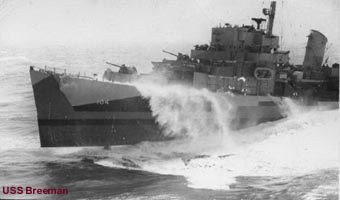
USS Breeman [DE-104] was launched September 4, 1943, and commissioned December 12, 1943 with Lieutenant Commander N. W. Hunter, in command.
On February 16, 1944 Breeman, sailed on anti-submarine sweeps of the Atlantic convoy routes. During this trip the Task Group made numerous attacks on enemy submarines. In March, they departed Casablanca
to search for submarines in the vicinity of the Cape Verde Islands. Later that month, Breeman sailed to Dakar, French West Africa, where she picked up a cargo of gold and transported it to New York. She departed New York for Bizerte, Tunisia, April 12th as part of a hunter-killer Task Group.
Breeman returned to the United States in May and underwent overhaul and training before steaming to Bermuda to join in a number of attacks on submarines. Later Breeman was assigned guard and escort duties including one unsuccessful search for enemy weather reporting submarines in the North Atlantic.
From August 11th until October 2nd Breeman did the same services off Port Everglades, Florida. Breeman was detached from her duties October 2, 1945 and proceeded to New York Navy Yard where she commenced her pre-inactivation overhaul. Breeman remained at New York until November 13, 1945 when she got underway for Green Cove Springs, Florida. She arrived November 16th and was subsequently placed out of commission, in reserve on April 26, 1946. She was transferred to China and renamed Tai Hu on October 29, 1948.
Breeman received one battle star for her World War II service.
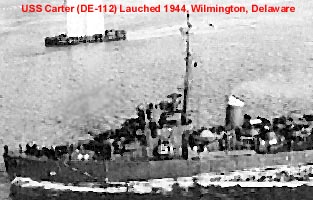
USS Carter [DE-112] was launched February 29, 1944 and commissioned May 2, 1944. On July 21, 1944, Carter sailed from New York
escorting a convoy bound for Bizerte, Tunisia, from which she returned on September 18th. After several training and escort duties throughout the rest of 1944, Carter, took up duties as an escort for shipping in the North Atlantic. Carter’s next convoy assignment was to Oran, in Northwest Algeria. After January 20,
1945, antisubmarine patrol from Casco Bay was the onlyassignment for the remainder of the war. Her constant vigilance was rewarded on April 22nd, when she picked up U-518 and with Neal A. Scott (DE-769) joined in a hedgehog attack, which sank the German submarine. On May 9th she made rendezvous at sea with U-858which she escorted to the designated surrender area. Carter next sailed to act as plane guard during carrier qualification flights off Florida. She arrived at Green Cove Springs, Florida, November 8, 1945, and was
placed out of commission in reserve there April 10, 1946. On December 14, 1948, she was transferred to Nationalist China, with whom she served as T’ai Chao. In December 1973 she was broken up for scrap.
Carter received one battle star for World War II service.
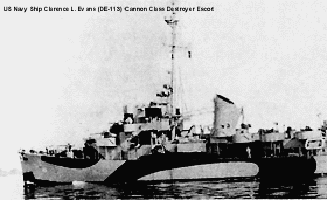
USS Clarence L. Evans [DE-113] Clarence L. Evans was launched March 22, 1944 and commissioned
June 25, 1944, Lieutenant Commander W. C. Hughes, USNR, in command. Evans first reported to the Atlantic
Fleet.
On September 2, 1944, Evans reported to Norfolk for duty in training pre-commissioning crews of other escort vessels. Here she conducted tests of newly developed 3″ ammunition and acoustic torpedo defense equipment. On October 19th she cleared Norfolk for the first of several convoy crossings from New York City to Glasgow, Southhampton, Plymouth, and Le Havre. These trips, which averaged about 30 days for each voyage, were alternated with training duties at New London or Casco Bay.
On May 29, 1945, Clarence L. Evans put in to Brooklyn Navy Yard for overhaul until June 22nd. She then reported to Quonset Point Naval Air Station for duty as plane guard during carrier qualification exercises. She cleared Narragansett Bay on August 17, 1945, for Miami, assumed plane guard duty until October 2nd, then cleared for Brooklyn and overhaul. Clarence L. Evans reported to Green Cove Springs, Florida, November 10th, where she was placed out of commission in reserve May 29, 1947. She was lent to France under the Military
Assistance Program on March 29, 1952 where she was renamed Berbere in service of the French Navy. Evans was returned to US Navy in 1960 and subsequently scrapped.
These brief histories offer hard evidence that we who live in the Delaware Valley have reasons for pride in our work and the contributions made in service to our country.
When I read stories like this. I just keep thinking we use to build such good ships. Now we turn out crap. Bad steel, crazy new designs ie The Zumwalt. Over priced bad designed carriers ie The Ford. It’s like no one is in charge.